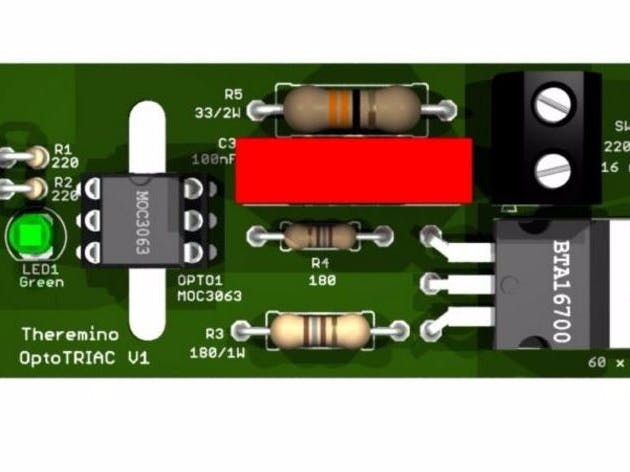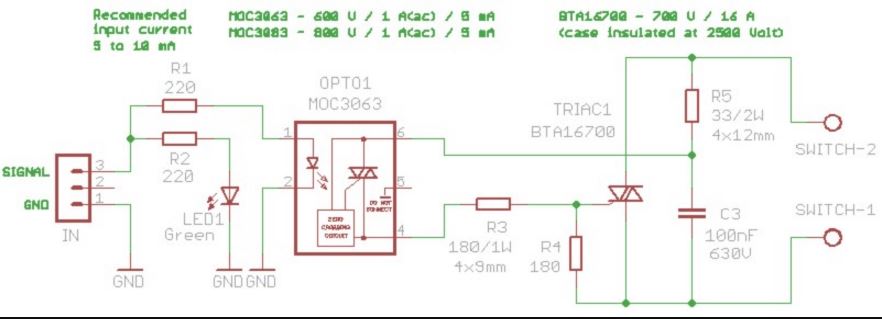This circuit is very similar to a power switch. It can turn on and off large loads, such as furnaces and boilers. And it also works well with inductive loads such as motors, transformers and large electromagnets.
By means of a photo-coupler “zero crossing”, the switching times are always at the precise moment of the passage of the zero. Then the commutations are clean, the electromagnetic interference are completely absent and do not develop dangerous extra voltage.
The input connector is a 3-pole, so follow the standard Thereminico which provides + 5VDC central pole. But, in this circuit the +5 Volt is not used, then you can use two single cables Dupont for signal and to GND.
If you have to drive multiple forms together, you could combine the Central Server with GND with a spot of solder on the bottom of the print. That way you could carry only one bulk cable (GND) and then use the Central Server to bring mass to neighboring modules.
This project is lucky. It concerns the Chinese by automating the screw-setting machines they use in production, then takes precedence over many other machines. It will be produced in record time and will soon be available on thereminostore.
ComponentsThe TRIAC must absolutely be BTA series (or equivalent) so that you have the metal part well-insulated (2500 Volts of isolation), that way you can attach it to metal parts without having to interpose an insulator. For anyone thinking of using non-isolated TRIAC and make do with mica insulation, you can't trust a home insulation with mica - the danger is real and anything can happen!
The photo-coupler must be a MOC3063 or a MOC3083. These two models are content to 5 but the cockpit and switch to the passage of the zero are important features and you have to respect them.
Add a fuseSimilar projects (for example, light controllers for incandescent lamps) usually include a fuse on the PCB. The idea would be to protect the TRIAC, and it would be a good idea if it worked, but in practice the fuse stops after the TRIAC has already melted.
Moreover, PCB fuse holders are usable only up to 6 amps and, as much as there are interchangeable glass fuses also from 10 amperes and over, their use is not in the rules and there is a risk that make precarious and dangerous contacts.
And finally, incredible but true, quality fuses that would have any hope of protecting the TRIAC costing twice the TRIAC.
Then this PCB fuse function is performed by the track that goes to the top clamp. This track is smaller than the other and will break in case of emergency. In an “emergency,” do not plan to protect the TRIAC but to avoid melting the wires in the electrical system or trigger the automatic.
If you plan to work in 16 ampere (and even bigger addition with TRIAC), it should strengthen the two slopes ranging from screw until TRIAC. Up to 10 ampere, just increase the thickness of the slopes using the pond and the welder; beyond the 10 ampere, you should add a bare copper wire welded on the slopes.
Always fit a small stretch of track, without tinning and without copper wire, with the function of emergency fuse. Or, you can add a panel mount fuse holder.
Keep the cold TRIACUp to a hundred watts, there are no problems, the TRIAC might also be without heat sink. But to get to 3 kW and beyond, a heat sink is absolutely necessary. The right solution for dissipating well is not to invent a small heat sink (as with slots), but take away the heat with an aluminum bracket and draw on a large metal surface, probably the container itself.
A good solution is an L of aluminum, as wide as the metal of the TRIAC and 2 or 3 mm thick. With this L, distance from live parts and fastening is made easy. The vertical part of the L can be screwed to a large metal wall that will provide the dissipation request.
Hazardous areaBe very careful! The area outlined with the red line is connected to the mains. Therefore we recommend this project only to those familiar with electronics.
For safety reasons, you should use an insulated container. The metal part of the TRIAC is isolated internally, and therefore can be screwed directly onto an aluminium heat sink. However, you should be careful to build well the heat sink; its shape must be precise so as not to get too close to the metal parts under voltage.







Comments
Please log in or sign up to comment.